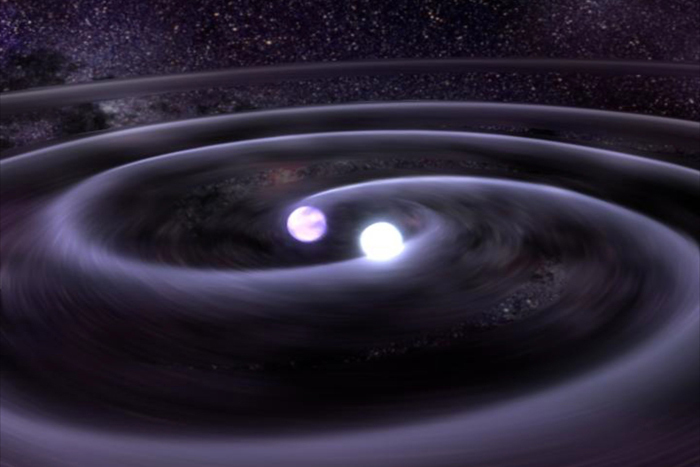Gravitational waves: will the global south provide the next pulse of gravity research?
19 February 2016 | Story by Newsroom
A little over a century ago, on 25 November 1915, Albert Einstein published a paper entitled "Die Feldgleichungen der Gravitation". Its contents would change the world forever.
Like any good scientific theory, Einstein's General Relativity not only explained the shortcomings of its predecessor, in this case Newtonian gravity, it also made predictions of new and unexpected phenomena. These included the bending of light by massive objects, the existence of black holes, the slowing down of time in strong gravitational fields and the very framework for the cosmology of the universe. All of these have withstood a century of intense scrutiny. But for 100 years one particular prediction in Einstein's theory of Gravity eluded the most ingenious testing.
That changed on 11 February 2016 with the news that gravitational waves have been discovered. As so often happens in astronomy research, the real event took place over a billion years ago. The detection was in September 2015. But the full gravity of the situation is only being revealed now: this is a new era in astronomy and physics.
The signal that started it all
On 14 September 2015 the Advanced Laser Interferometer Gravitational-wave Observatory (LIGO), a newly upgraded, purpose-built gravitational wave detection experiment based in the USA, received a signal from a binary system of two massive black holes merging into a single larger one, 1.2 billion light years away. The final front's here.
This event was so cataclysmic that the gravitational wave released in the final moments of the binary system's mortal dance produced the first ever observed gravitational wave signal. It was so large that LIGO scientists report being able to visually "see" the signal in the data.
To put this in perspective, the level of accuracy needed to see this tiny ripple in spacetime required measuring a change in length of a 4km long channel the size of a fraction of the diameter of a proton! The level of certainty in this result is given, in physics terms, as a 5.1 sigma event. In simple terms, the likelihood that this is a coincidence is less than 1 in 3.5 million.
And it all goes back to Einstein.
Evasive waves
Although their existence had never been directly detected, gravitational waves – ripples in the very fabric of spacetime – are so-well studied that they are taught even to undergraduate students.
So why are they so difficult to detect? One reason is that, unlike light, gravitational waves are incredibly weakly interacting and can pass through most matter, of arbitrary density, unhindered. A second one is that, unlike the electric force field which can be felt by individual charges in a detector, the gravitational field is tidal in nature and requires extensive apparatus to detect it.
Taken together, these would merely imply that any detection of gravitational waves would take some of the largest, most sensitive experimental apparatus ever built. Difficult, but surely not that difficult. After all, we've built the Large Hadron Collider and discovered the Higgs. No, there is one more crucial element to this detection: luck.
Producing a gravitational wave large enough for us to detect out here in the galactic suburbs takes some of the most cataclysmic events in the universe, events matched in their violence only by how rare they are. Until now.
Could Africa be next?
Today, thanks to the remarkable work of more than 1000 scientists involved in LIGO, there is certainty: Einstein was right, again.
His theory about gravitational waves sparked a huge debate when it was first published, engaging some of the world's most famous scientists. The beautiful chirp heard across the world on 11 February 2016 was the final word in this particular century-long conversation. However, the next phase of the conversation is far from over.
Physicists and astronomers have learnt so much, yet our work is far from done. The next frontier is here. Where will be the next big announcement be made in this new era? Who will write the next chapter in this intergenerational dialogue? Today is a day for boldness. So allow us, as African scientists, to be bold. With the Square Kilometre Array project to be constructed across Africa and Australia, the global South and indeed Africa itself is poised to provide the next pulse of gravity research. Our time has come.
By Amanda Weltman, SARChI in Physical Cosmology, Department of Mathematics and Applied Mathematics, and Jeff Murugan, Associate Professor of Mathematical Physics, University of Cape Town.
|
This article first appeared in The Conversation, a collaboration between editors and academics to provide informed news analysis and commentary. Its content is free to read and republish under Creative Commons; media who would like to republish this article should do so directly from its appearance on The Conversation, using the button in the right-hand column of the webpage. UCT academics who would like to write for The Conversation should register with them; you are also welcome to find out more from carolyn.newton@uct.ac.za. |
![]()
 This work is licensed under a Creative Commons Attribution-NoDerivatives 4.0 International License.
This work is licensed under a Creative Commons Attribution-NoDerivatives 4.0 International License.
Please view the republishing articles page for more information.










